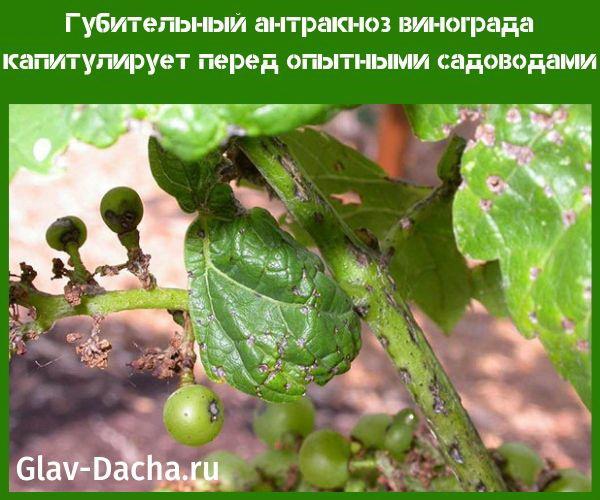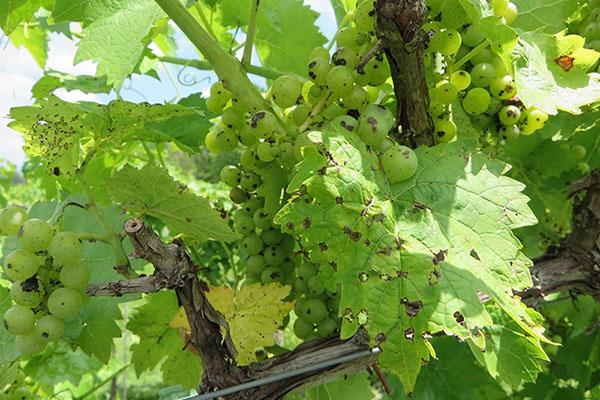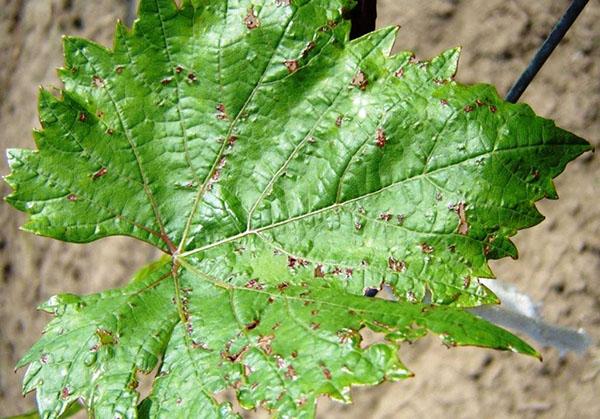The deadly grape anthracnose capitulates to experienced gardeners
 Fungal diseases of plants spread very quickly throughout the garden. Therefore, it is necessary to treat grape anthracnose when the first symptoms appear. First, pathogenic microorganisms infect the leaves, and then the shoots and fruits of the culture. Timely intervention, as well as preventive measures, will help protect the plantation from an invisible pest.
Fungal diseases of plants spread very quickly throughout the garden. Therefore, it is necessary to treat grape anthracnose when the first symptoms appear. First, pathogenic microorganisms infect the leaves, and then the shoots and fruits of the culture. Timely intervention, as well as preventive measures, will help protect the plantation from an invisible pest.
All about anthracnose grapes

This terrible disease manifests itself in this way:
- Leaves. On the foliage, black dots appear on both the outside and the inside. Later, these areas grow and dry up. As a result, the leaves fall off.

- Shoots. The vine is covered with dark small silvery spots with a dark border. As a result, they completely merge, forming deep cracks, wounds. During the heat, the bark, which has been struck by the grape anthracnose, dries up, and in rainy weather, it rots.

- Inflorescences. Fungus damage occurs long before flowering begins. Brown spots quickly spread on the hands. They increase in volume, which leads to drying and death of living tissue, as well as the fall of buds.
- Bunches. Necrosis appears as round brown spots. The skin in these places becomes very dense. Over time, the fruits dry up and then fall off.

Faced with a dreaded fungal disease, many gardeners ask how to protect their crops and how to treat them. A photo of grape anthracnose shows that pathogenic microorganisms quickly parasitize the culture. Such plants become unable to absorb nutrients from the soil. By winter, they weaken, and at the first frost they die.
Reasons for contamination of the vineyard with anthracnose. Soil acidity is above 6.5 pH, potassium and calcium deficiency in the soil. Excessive moisture in the garden caused by improper plant care.
Grape anthracnose can be defeated
 Before starting treatment, it is necessary to completely cut and then destroy the affected parts of the culture. They are the sources of infection.
Before starting treatment, it is necessary to completely cut and then destroy the affected parts of the culture. They are the sources of infection.
The method of dealing with it will depend on the stage of progression of the disease:
- First signs. The vineyard is treated with a 3% solution of Bordeaux liquid. After 7 days, the procedure is repeated, but only with 1% composition.
- First stage. Planting spray solution of copper sulfatediluted at the rate of 100 g / 5 l.
- Severe infection. Preparations for the treatment of grape anthracosis: Ordan, Kuproskat, Acrobat MC, Fundazol, DNOK and Previkur. After the first treatment, the next one is carried out after 14 days. These strong compositions are recommended to spray the planting in late autumn (after pruning the vine), as well as in early spring.
 However, it is worth remembering that taking preventive measures is much better than treating grape anthracnose. For this, fungicides Hurus and Ridomil are used. Well-developed shrubs of the plant, the length of the shoots of which are more than 10 cm, are sprayed with copper-containing solutions of such agents as Poliram, as well as Kartotsid.The anthracnose of grapes recedes when using fungicides.
However, it is worth remembering that taking preventive measures is much better than treating grape anthracnose. For this, fungicides Hurus and Ridomil are used. Well-developed shrubs of the plant, the length of the shoots of which are more than 10 cm, are sprayed with copper-containing solutions of such agents as Poliram, as well as Kartotsid.The anthracnose of grapes recedes when using fungicides.
Effective drugs for grape anthracnose: Fundazol, Skor, Abiga-Peak and Ridomil. Many gardeners successfully fight fungal diseases with the help of biological products: Planriz, Gaupsin and Mikosan.
How to protect grapes from anthracnose
 In addition to using chemical and biological drugs, many gardeners use folk remedies.
In addition to using chemical and biological drugs, many gardeners use folk remedies.
Such prophylactic formulations include:
- Garlic infusion. To prepare the composition, take several broken cloves of garlic, pour boiling water (1 l) and leave for a day. In the resulting infusion, 2 tbsp. l salt, 50 g of soap (household) and a solution of potassium permanganate (1%) or copper sulfate. The suspension is brought up to a volume of 5 liters. The anthracnose of grapes usually recedes.
- Essence of hay. Fresh dried grass is tamped into a container and poured with water. After a week, the vineyard is sprayed with concentrate. This procedure is repeated every 14 days.
- Fertilizers. Potash-phosphorus complexes, as well as wood ash, are timely introduced to the site.
It is worth knowing that the content of the main elements in different types of ash is different. So, calcium in shale ash - 65-80%, deciduous / coniferous species - 30-35%. Sunflower stalks contain up to 40% potassium, and cereal straw - 20-30%.
 To protect their vineyard from anthracnose, most gardeners try not to over-water the site too much. They mulch the garden after each watering, crown thinning is carried out, and weeds are regularly pulled out. In addition, farmers inspect their lands after a hail hurricane. Farmers treat damaged branches of a plant with protective preparations. In addition, they need to carefully harvest the entire crop, collecting even fallen leaves and branches.
To protect their vineyard from anthracnose, most gardeners try not to over-water the site too much. They mulch the garden after each watering, crown thinning is carried out, and weeds are regularly pulled out. In addition, farmers inspect their lands after a hail hurricane. Farmers treat damaged branches of a plant with protective preparations. In addition, they need to carefully harvest the entire crop, collecting even fallen leaves and branches.
Anthracnose Resistant Grape Varieties
 Prevention and proper agricultural practices will, of course, protect the crop from fungal diseases. However, growing grape varieties that are resistant to anthracnose is a safer option.
Prevention and proper agricultural practices will, of course, protect the crop from fungal diseases. However, growing grape varieties that are resistant to anthracnose is a safer option.
These varieties include:
- Sauvignon;
- Yasya;
- Saperavi;
- Tsolikouri;
- Riesling;
- Nimrang;
- Tangra;
- Shasla white.
However, it is also necessary to know the varieties that are vulnerable to fungal attack. Among them, Lydia, Isabella, Husayne and Karaburni are considered the most defenseless. Moreover, they are practically not affected by false powdery mildew, gray rot and powdery mildew.
 Thus, recognizing the first signs of grape anthracnose, the gardener needs to act immediately. Since it is very difficult to cure a fungal disease, it is better to prevent it. To do this, you need to take preventive measures on time and observe the agricultural technology of growing crops.
Thus, recognizing the first signs of grape anthracnose, the gardener needs to act immediately. Since it is very difficult to cure a fungal disease, it is better to prevent it. To do this, you need to take preventive measures on time and observe the agricultural technology of growing crops.